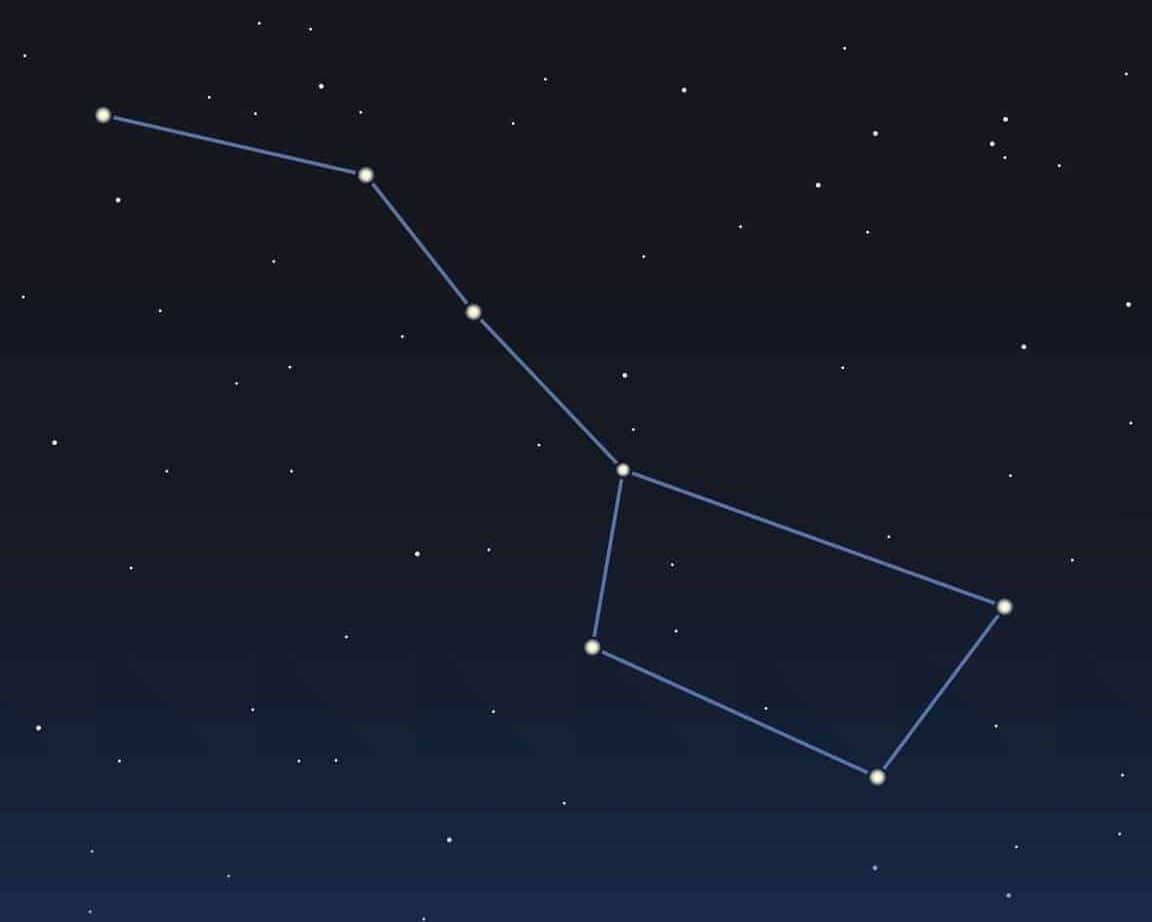One of the most recognizable constellations in the night sky, the Big Dipper has a distinctive shape that resembles a dipper. It is easily identifiable even to those who are not well-versed in astronomy. This constellation has been observed and documented for thousands of years, with mentions dating back to ancient civilizations such as Egypt, Greece, China, and Babylon. In fact, it was prominently featured in the work of Ptolemy, a renowned astronomer who compiled the astronomical knowledge of his time.
Back in ancient Greece, the constellation of the Big Dipper was linked to the nymph Callisto. This nymph was beloved by the supreme god Zeus and became the mother of his son, Arcadus. When Hera, Zeus’ wife, discovered their affair, she punished Callisto by transforming her into a bear. For a long time, the bear roamed through the forest until one day Arcadus, now grown, stumbled upon her during a hunting trip. Unaware that the bear was his mother, Arcadus nearly shot her, but Zeus took pity on Callisto. He reached down from the heavens and lifted the bear by her tail, placing her in the sky. And so, the constellation of the Big Dipper was born.
The constellation can be easily spotted in the night sky due to its distinctive shape. The Big Dipper resembles a ladle or dipper, making it easily recognizable. Other nearby constellations include Canes Venatici, Leo, and Draco. Additionally, the Big Dipper can be used as a guide to locate the Little Dipper, which is situated nearby.
In total, there are seven stars within the constellation, each varying in distance from our planet and brightness. The star positioned at the highest point of the ladle, opposite the handle, is known as Dubhe. Dubhe is the second brightest star in the constellation, thanks to the fact that it is actually composed of multiple stars that appear as one from Earth. In total, there are three stars within Dubhe, with two of them sharing similar characteristics to our Sun. The third star is a red giant and is in the process of dying. Eventually, it may evolve into a black hole.
Merak, located at the opposite end of Dubhe in the Big Dipper, is an exceptionally luminous star that cannot be compared to the Sun. By drawing a straight line through these two stars, it leads directly to Polaris in the Little Bear constellation.
The other two stars in the Big Dipper’s bucket are the lower Fekda, which resembles the Sun, and the upper Megrez. The handle of the bucket begins with Aliot, which is the alpha star of the Big Dipper and also one of the brightest stars in the entire night sky, ranking 33rd in brightness.
In the center of the handle of the Big Dipper is Mizar, a binary star. The second component of this binary system is known as Alcor. Alcor can be faintly observed next to Mizar, but only if one looks closely.
At the end of the ladle’s handle, you can find the star Benetnash, also known as Alqaid. These names originate from Arabic and mean “leader of the mourners”. Interestingly, the Arabs also associate the Big Dipper with funeral processions.
Variant 2
The Big Dipper is the largest constellation in the northern sky. It is most visible during the first half of spring, but can be seen throughout the year. It is adjacent to the Dragon, the Wolf, the Hound Dog, the Lesser Lion, the Lion, Veronica’s Hair, the Moose, and the Giraffe.
The Great Bear is an extremely ancient celestial object that has been used for navigation since the time of the ancient Greeks. Originally known as Arctos, Chariot, or Horse at Rest, it acquired its modern name due to its association with Greek myths. According to one version of the myth, the constellation represents the nymph Callisto, who was transformed into a bear by Zeus to protect her from Hera. Another legend suggests that the Great Bear and the Little Bear are actually two nymphs hidden in the sky by Zeus to shield them from Cronus. The constellation was first documented by Ptolemy in his famous work, the Almagest.
With an area of 1280 square degrees, the Big Dipper is the third largest constellation in the night sky.
The Big Dipper contains over 120 visible objects, with its seven brightest stars forming the shape of a dipper. These stars, known as Dubhe, Merak, Fekda, Megretz, Aliot, Mitsar, and Benetnash, are easily recognizable and are a popular subject for stargazers.
The alpha star of the Great Bear is known as Dubhe. Her name signifies “bear.” Dubhe is part of a binary system and has a magnitude of 1.76 m. This star is located 123 light years away from our planet.
Merak, the beta star of the constellation, belongs to the main sequence stars and has a magnitude of -2.37 m. It is positioned at a distance of approximately 80 light years.
Fekda is recognized as the gamma star of the constellation. It possesses a magnitude of 2.44 m and is classified as a main sequence star. Fekda is situated 83 light years away from our planet.
Megrez, the delta star of the Great Bear, is named as such. It is a member of the main sequence star category and has a magnitude of 3.3 m. This star is located 58 light years away from us.
Aliot, the epsilon star of the constellation, is known for its brightness. With a magnitude of 1.7 m, it shines the brightest among the stars in the bear. Its distance from Earth is approximately 81 light years.
Mizar, known as the zeta star of the bear, is a fascinating system of two double stars. With a magnitude of 2.23 m, it adds to the beauty of the constellation. Mizar is located approximately 82 light years away from our planet.
Benetnash, representing the constellation, is a main sequence star. It has a magnitude of 1.8 m, making it one of the prominent stars in the bear. Benetnash is situated at a distance of around 100 light years from us.
In addition to these remarkable stars, the bear constellation also contains other celestial objects. These include spiral and spindle galaxies, adding to the cosmic wonders of the region. Moreover, a massive planetary nebula can also be found there. Furthermore, two exoplanets have been discovered within the boundaries of this constellation.
Image of the Big Dipper Constellation in a Message
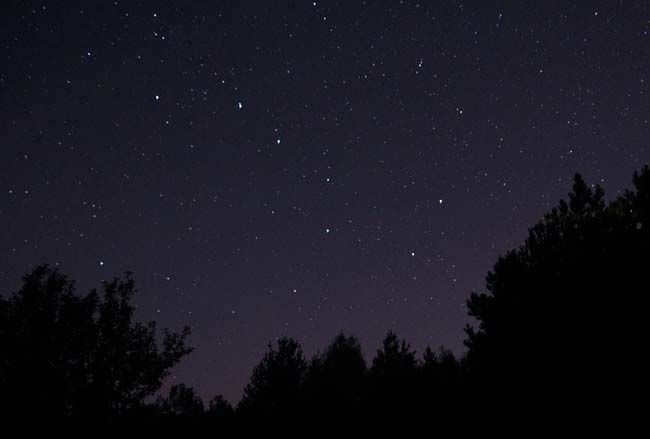
Trending subjects at present

- Utilization of Information Technology in Schools The educational system must keep pace with contemporary technology. The incorporation of computers and digital information technologies into the learning process can enhance the quality of education.
- The Volga River The Volga River is recognized as the most powerful and longest river in Russia. It spans over 3500 km in length. Its source originates in the Valdai Upland and it flows into the Caspian Sea.
- Anton Pavlovich Chekhov Chekhov is a prominent figure in Russian literature, playing a significant role in concluding the golden age of Russian literature, which can be roughly extended until the early 20th century. Many of his works
- Moles are fascinating creatures belonging to the mammal family. There are over 30 different species of moles, with the exception of Africa where they are not found at all.
- Ancient India is home to one of the oldest and most intriguing civilizations in the East. This country has endured for thousands of years.
- The brown bear, a resident of the forest, is one of the most well-known predators. It frequently appears in fairy tales and folklore, especially in Russian stories.

The Great Bear – is a group of stars in the northern part of the celestial sphere. The Great Bear – is the third largest constellation in terms of its size (after Hydra and Virgo).
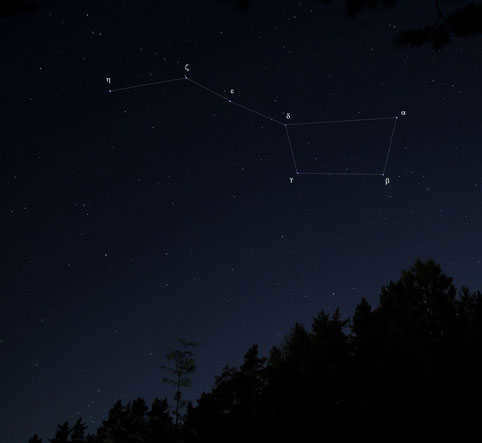
Legend
An ancient constellation. It is believed that it was initially linked exclusively to the brilliantly colored group of stars known as The Big Dipper. According to Greek writers (such as Aratus of Soliloquy, “Apparitions and Predictions”, 3rd century B.C.), the constellation was utilized by the ancient Greeks for celestial navigation.
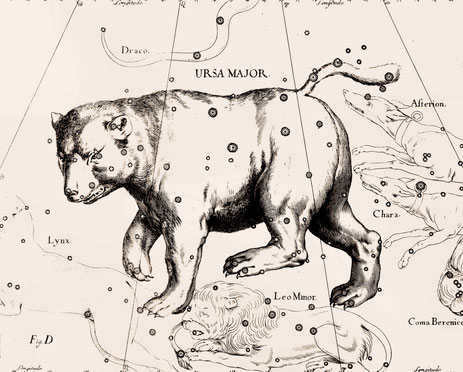
According to Greek mythology, Zeus changed the nymph Callisto into the Dipper in order to protect her from Hera’s revenge. Another story, recounted by Philemon of Syracuse, tells of two Cretan nymphs who were also transformed into bears by Zeus as infants, in order to hide them from Cronus. They were later placed in the sky as the Big and Little Bears.
This constellation is included in Claudius Ptolemy’s Almagest catalog of the celestial sphere.
In Sanskrit, the constellation is known as “Sapta Rishi,” which translates to “Seven Sages.”

Astronomical Objects and Celestial Bodies
The constellation is composed of seven prominent stars that collectively form the widely recognized Ursa Major asterism. This group of stars has been observed and named by various civilizations throughout history, adopting different titles such as The Big Dipper, The Plough, The Great Bear, The Wagon, The Seven Sages, and many more.
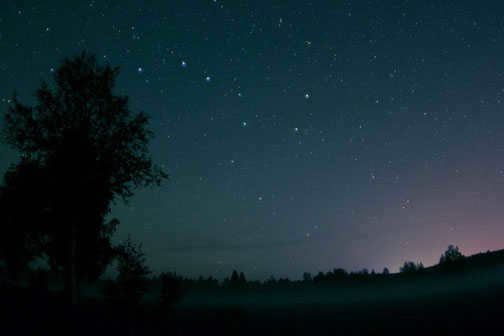
By utilizing the two outermost stars of this constellation (α and β), it is possible to locate Polaris. The stars Merak and Dubhe, which comprise the barrier of the Bucket, are referred to as the Pointers because a line drawn through them leads to Polaris. Polaris can be found in the Little Bear constellation.
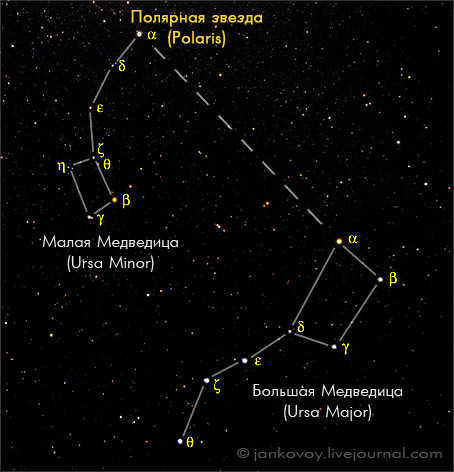
The stars in the Big Dipper all have Arabic names: Dubhe (α of the Big Dipper) translates to “bear”; Merak (β) means “loincloth”; Fekda (γ) is “thigh”; Megretz (δ) is “beginning of the tail”; Aliot(ε) has an unclear meaning, but it is likely “curd”; Mitzar (ζ) translates to “girdle” or “loincloth”. The last star in the handle of the Big Dipper is called Benetnash or Alqaid (η), which means “leader of the mourners” in Arabic.
Six of the stars in the Big Dipper have a luminosity of 2nd stellar magnitude, while Megrez has a luminosity of 3rd stellar magnitude.
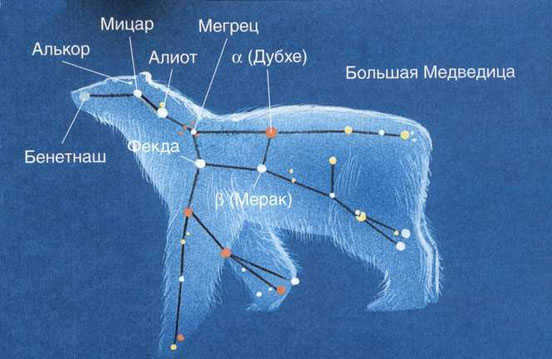
It is interesting to note that, with the exception of the outermost stars α and η, the 5 inner stars of the Big Dipper actually belong to a single group in space known as the moving cluster. This cluster moves quite rapidly across the sky, causing the shape of the Big Dipper to change significantly in approximately 100,000 years.
The spiral galaxy M81 and the spindle galaxy M82, separated by an angle of just 38′, make up the central core of what could potentially be the nearest group of galaxies to us, located about 7 million light-years away. Additionally, the spiral galaxy M101 appears flat when viewed face-on.
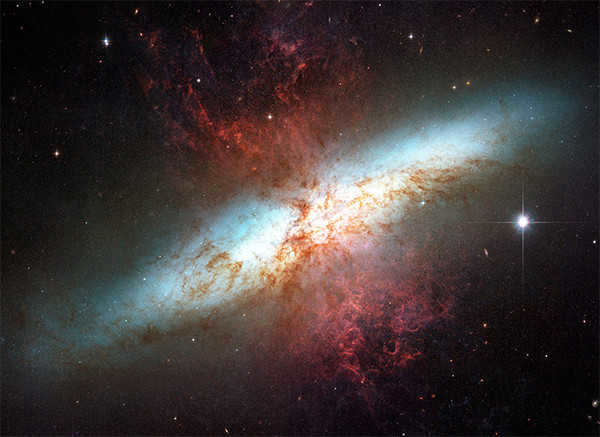

Here we have a galaxy called Owl (M97) that lacks almost any detail. It is one of the largest planetary nebulae and is much closer to us, within our own Galaxy.
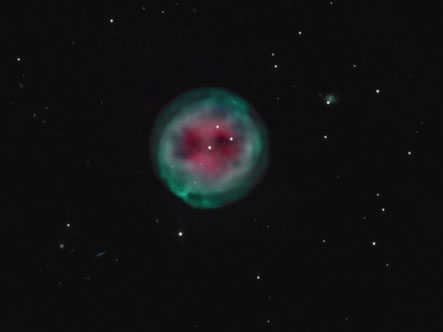
Observation
The optimal conditions for observing the Big Dipper are in the months of March and April. It can be seen throughout Russia all year round, except for the autumn months in southern Russia when it appears low on the horizon.
+ Astroplot: 53°20′56.505″ N 83°46′07.735″ E, Habs. = 209 m.

Ursa Major: The Great Bear Constellation
Ursa Major is a prominent constellation in the northern hemisphere, known for its distinct shape resembling a large bear. Its seven bright stars form the famous Big Dipper, which has been recognized and named by various cultures throughout history. Some of its alternative names include the Elk, the Wagon, the Teslo, the Plow, and the Seven Wise Men. According to Greek mythology, Ursa Major is associated with the story of Callisto, a nymph who was transformed into a Medusa by Zeus to protect her from Hera’s wrath. Spanning over 1279.7 square degrees in the sky, this constellation boasts 210 stars that can be observed without the aid of a telescope.
The stars α and β are known as Pointers due to the fact that a straight line drawn through them aligns with Polaris. Each star in the Constellation has its own unique name: Dubhe (α) translates to “bear” in Arabic; Merak (β) means “loins”; Fekda (γ) means “thigh”; Megrez (δ) means “root” (referring to the beginning of the tail); Alioth (ε) has an unclear meaning; Mizar (ζ) means “loincloth”; Alkaid (or Benetnash, η) means “master”. All of these stars have a stellar magnitude of 2-3. However, Bayer’s system of assigning Greek letters to stars based on decreasing luminosity isn’t applicable to the Big Dipper: in this constellation, the order of the letters simply corresponds to the order of the stars. Adjacent to Mizar, the observant eye can spot the star Alcor with a magnitude of 4, which translates to “insignificant” or “forgotten” in Persian.
It is interesting to note that the five inner stars of the Big Dipper (excluding the outermost stars α and η) actually constitute a cohesive group in space, exhibiting relatively rapid motion across the celestial sphere. As a result, the configuration of the Big Dipper undergoes significant changes over a span of 100 thousand years. Numerous galaxies and galaxy clusters have been documented in the vicinity of Ursa Major using powerful telescopes.
Scientific name: Ursa Major
Jan Hevelius’ atlas and the depiction of the Big Dipper:
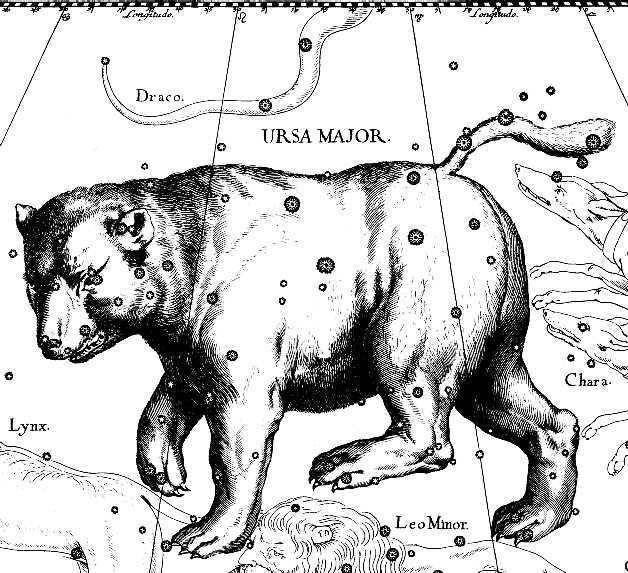
The magnificent bear: a constellation of wonder
Source: The Astral Gazette
Date of publication: Sunday, August 4, 2002
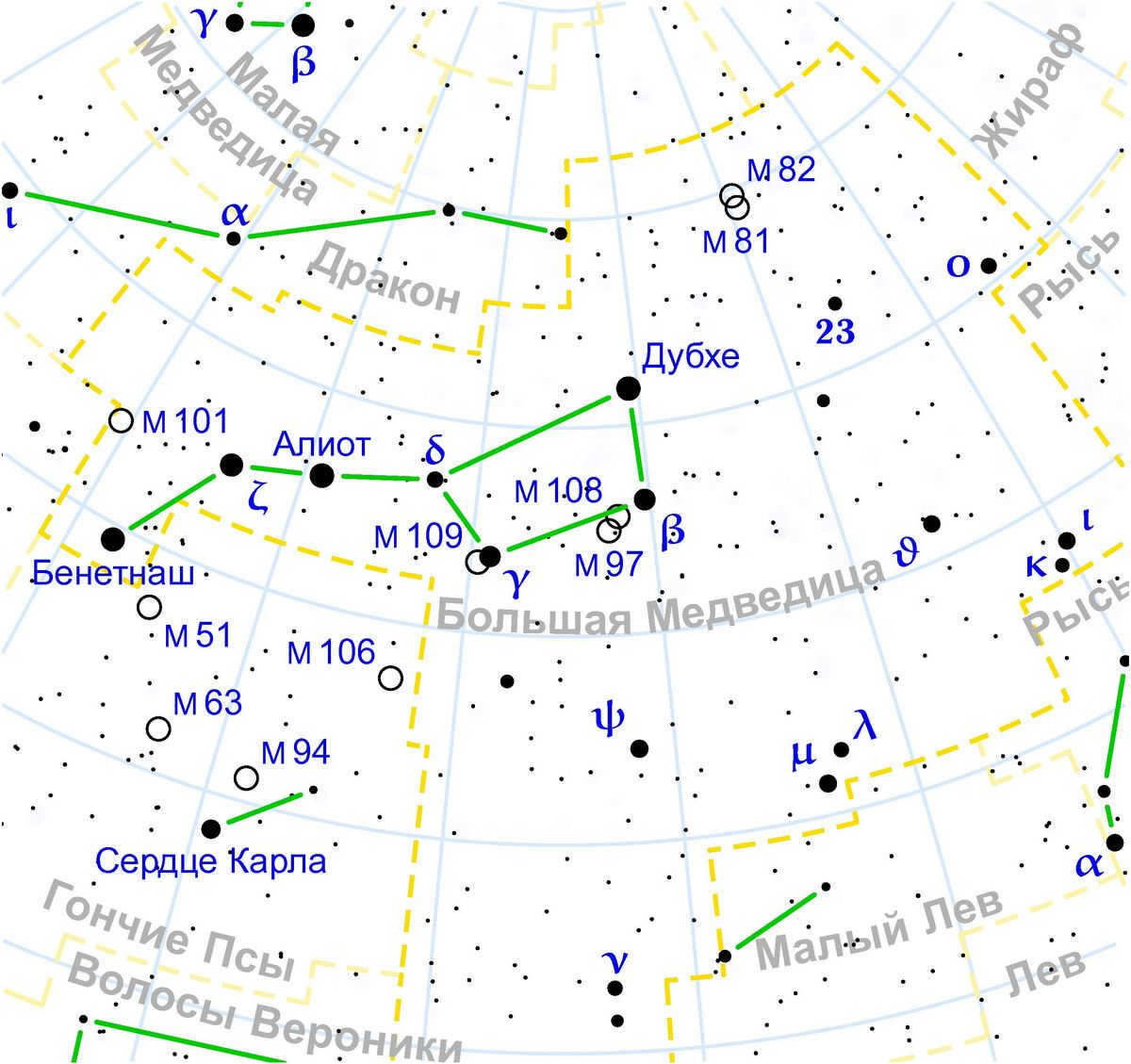
Ursa Major – is a group of stars located in the northern part of the sky. The seven stars that make up Ursa Major create a shape that resembles a ladle with a handle. The two brightest stars in this constellation, Aliot and Dubhe, have a luminosity equivalent to a magnitude of 1.8. By using the two outermost stars (α and β) of this shape, one can easily locate Polaris, also known as the North Star. The best time to observe Ursa Major is during the months of March-April. This constellation is visible throughout Russia all year long, with the exception of the autumn months in southern Russia when Ursa Major is closer to the horizon.
Stellar formations and constellations [ edit ]
The Big Dipper is the third largest constellation in terms of area (after Hydra and Virgo), consisting of seven bright stars that form the famous Big Dipper. This group of stars has been known since ancient times by various civilizations and has been given different names such as The Bucket, The Plow, The Elk, The Wagon, The Seven Wise Men, and more. Each star in the Big Dipper has its own Arabic name: Dubhe (α) means “bear”; Merak (β) means “loins”; Fekda (γ) means “thigh”; Megretz (δ) means “beginning of the tail”; Aliot (ε) has an unclear meaning, but it is believed to refer to “curd”; Mitsar (ζ) means “kushak” or “loincloth”. The final star in the handle of the Big Dipper is called Benetnash or Alqaid (η); in Arabic, al-qaid banat nash translates to “leader of the mourners.” This poetic description stems from the Arabic folk interpretation of the Big Dipper constellation. The Greek letter designation of the stars simply follows the order of the stars.
Another interpretation of the asterism is seen in its alternative name The Catafalque and the Mourners.. In this perspective, the asterism is likened to a funeral procession: with mourners leading the way, followed by funeral stretchers. This provides an explanation for the star η of the Big Dipper being referred to as the “leader of the mourners.”
Interestingly, the 5 inner stars of the Ladle (excluding the outermost α and η) are part of a single spatial group known as the moving cluster of the Big Dipper, which moves across the sky at a relatively fast pace. Dubhe and Benetnash move in the opposite direction, causing the shape of the Ladle to change significantly over a span of approximately 100,000 years.
The stars Merak and Dubhe, which form the wall of the Big Dipper, are known as the Pointers because a line drawn through them points directly to Polaris, the North Star (located in the constellation Ursa Minor). Six of the stars in the Big Dipper have a brightness of the 2nd magnitude, while only Mizar has a brightness of the 3rd magnitude.
Next to Mizar, which was the second double star discovered through a telescope (by Giovani Riccioli in 1650; although Galileo may have observed it as a double as early as 1617 [1]), lies the 4th magnitude star Alcor (80 Ursae Majoris), which means “forgotten” or “insignificant” in Arabic. It is believed that the ability to see Alcor has been a test of visual acuity since ancient times. The pairing of Mizar and Alcor is often seen as the asterism known as the “Horse and Rider“.
A unique asterism known as The three leaps of the gazelle, originating from Arabic culture, consists of three pairs of closely spaced stars. These pairs are arranged in a straight line and are evenly spaced apart, resembling the hoofprints of a gazelle as it moves in leaps and bounds. The stars that make up this asterism include:
Aliot, Mizar, and Benetnash create an elongated arc that directs towards Arcturus, the brightest star located north of the celestial equator. Arcturus is also the brightest star visible in the spring season in the middle latitudes of Russia. If this arc is extended further south, it points towards Spica, the brightest star in the constellation Virgo.
Laland 21185, a red dwarf located near Alula Severnaya and not visible to the naked eye, is one of the closest star systems to Earth. It is surpassed in proximity only by Alpha Centauri, Barnard’s Star, and Wolf 359. Another star, Groombridge 1830, can be observed with binoculars and is only surpassed in motion by Barnard’s Star and Kapteyn’s Star. Over the course of a century, it has shifted by about a third of the size of the moon [2].
The Big Dipper is the third largest constellation in terms of area, but it has an unusually low number of variable stars. As of 2011, it does not rank among the top ten constellations in this regard.
Additional items [ edit ]
In the Big Dipper region, there are various other celestial objects. M 101, a spiral galaxy, appears flat when viewed. On the other hand, M 81 and M 82, both spiral galaxies, are positioned close together, with only a 38′ angle between them. They are believed to be the nearest group of galaxies to our own, located approximately 7 million light-years away. However, the Owl nebula (M 97), which is one of the largest planetary nebulae, is much closer to us, within our own Galaxy. It is significantly more detailed than the galaxies in the Big Dipper region. In 2002, astronomers from the University of Texas at Arlington made a remarkable discovery – two exoplanets orbiting the star 47 of the Big Dipper. Additionally, in 2001 and 2003, radio messages were sent from Earth to potential extraterrestrial civilizations, directed towards the star mentioned above.
In October 2013, astronomers made an incredible discovery in the Big Dipper constellation. They found a galaxy called z8 GND 5296 with a redshift value of 7.51. This galaxy was incredibly distant, with its light taking 13.02 billion years to reach us. However, their excitement was short-lived as on March 1, 2016, an even more distant galaxy was discovered in the same constellation. This galaxy, named GN-z11, had a redshift value of 11.1 and was a staggering 13.4 billion light years away from Earth, making it the most distant object ever observed in the Universe.
History [ edit ]
Ancient constellation. It is believed that originally it was associated only with the prominent asterism known as the Big Dipper. The ancient Greeks referred to this constellation by different names, including Helica (“shell”), Arctos (“bear”, “bearess”), and Chariot. Scholars believe that the oldest name for this constellation is Arktos, which dates back to the time of hunting. According to Greek authors such as Aratus of Soli in the 3rd century BC, the constellation was used by the ancient Greeks for navigation.
According to Greek mythology, Zeus transformed the beautiful nymph Callisto into a bear to protect her from the wrath of Hera. Another myth, recounted by Philemon of Syracuse, tells the story of two Cretan nymphs whom the young Zeus also transformed into bears to hide them from Cronus. He later placed them in the sky, where they became the Big and Little Bears.
The constellation is known as “Sapta Rishi” in Sanskrit, which translates to “Seven Rishis (Sages)”.
The Evenks associate the constellation with the cosmic elk Haglan, while in Russian folklore it is sometimes referred to as “Elk” [3].
In Chinese astronomy, the seven stars of the constellation are known as the Northern Bucket (Beidou). In ancient times, the handle of the ladle pointed towards the pole and was used by the Chinese for timekeeping.
The Bashkirs refer to the constellation as “Etegәn”, in honor of the seven girls from the Bashkir legend “Ete ҡyҙ” or “Seven Girls” in Russian.

